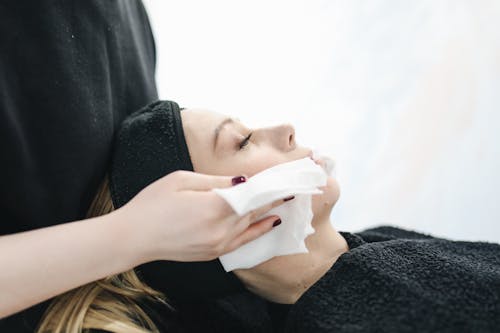When you think of dermaplaning, you probably think of those really satisfying Instagram videos where you can see the procedure happening and producing what looks like too-good-to-be-true results. The client’s skin glows after the clinician has sloughed off what looks like what looks like years of dead skin and peach fuzz. But what is it really? A clever tool that tells women that yet another form of body hair is a beauty sin? Or is it a genuinely useful tool for exfoliation, skin brightening and combatting hyperpigmentation?
We did a deep dive to find out.

Dermaplaning, simply put, is a skin treatment designed to exfoliate and remove barriers such as hair from the skin using a scalpel-like tool called a dermatome. It is a procedure to be carried out by a clinical aesthetician, and it involves scraping the dermatome – which is like an electric razor – across the skin to get ride of everything from dirt build-up to peach fuzz.
The idea is that removing these barriers makes it easier for your skin care products to penetrate your skin and therefore increase their effectiveness in cleansing and brightening your skin. There are many reported benefits to this treatment, including clients claiming that their skin feel brighter and smoother after the treatment. The treatment can combat hyperpigmentation like old acne scars and allow your makeup to ‘sit’ better on your skin without the barrier of hair and dead skin cells. It’s highly recommended by some doctors for women who are finding their mental health impacted by the presence of thick, dark hair around their lower cheek or chin areas.

However, whether or not you can undergo this treatment and how well it will work for your skin type depends on your skin type and skin history.
Though most people’s skin will experience little to no reaction the treatment, it can create swelling and redness as well as a burning sensation for up to two days post-treatment. It may also increase risk of sunburn.
This treatment isn’t something you can take advantage of if you currently have acne, rosacea, eczema, psoriasis or sunburn. There are also some prescription medications that you must not be taking if you want to try dermaplaning, so it is essential to always have this treatment carried out by a licensed aesthetician or doctor.
At-home dermaplaning kits have been popular in recent years, but it’s recommended that you get this treatment done by a professional as if something goes wrong it can lead to bad scarring or even infection if you don’t undergo a consultation to see if your skin is suitable for the procedure. If the scalpel catches on the skin, it can lead to permanent scarring, even if a safety guard is used. Plus, only certain hair on the skin is supposed to be removed as not all the hair on your face is the vellus (facial) hair that is removed in the treatment. Only licensed doctors and aestheticians can do this job safely and correctly.

If this is a treatment you’re considering booking yourself in for, it’s important to note that you should avoid exfoliating your face for at least three days before your appointment. As well as this, stay away from direct sunlight as it will increase your chance of sunburn, meaning you won’t be able to have the procedure. Doctors also advise against tanning in the days leading up to the appointment.
Your recovery time after the procedure is fairly minimal – there’s no rest or recovery really needed as it’s a surface procedure only. But it’s important to properly look after your newly exposed skin post-procedure. This means using a broad spectrum SPF and an intense moisturiser afterwards. Your skin will be much more exposed and sensitive to it’s essential to protect it from UVA and UVB rays in the days after your procedure.






